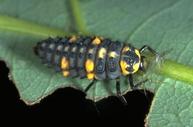|
|
Dry Beans >
Year-Round IPM Program >
Stand Establishment >
Natural Enemies of Aphids
Dry Beans
Natural Enemies of Aphids
On this page
- Convergent lady beetle
- Sevenspotted lady beetle
- Parasitic wasp
|
- Bigeyed bug
- Damsel bugs
- Green lacewings
|
- Minute pirate bugs
- Syrphid fly
- Fungal diseases
|
Click on photos to enlarge. Names link to more information on identification and biology.

Convergent lady beetle (larva)
Identification tip: Larvae are elongate with long legs and resemble tiny alligators.
|

Convergent lady beetle (adult)
Identification tip: Adults are mostly orange with black spots and converging white marks on the thorax. Some individuals have fewer spots, and some, no spots.
|

Sevenspotted lady beetle (larva)
Identification tip: Larvae are elongate, grayish, yellow- spotted, and alligator shaped.
|

Sevenspotted lady beetle (adult)
Identification tip: Adults have a black thorax with white along the front margin. Seven black spots are on the red or orangish wing covers, which may have 2 white areas near the front.
|

Parasitic wasp
Identification tip: Parasitic wasps such as this Aphidius sp. lay their eggs in aphids.
|

Parasitic wasp (aphid mummy)
Identification tip: The cuticle of aphids killed by parasitic wasps turn bronze (or black) and crusty and are called mummies. The exit hole is evidence that the parasitic wasp has emerged.
|

Bigeyed bug
Identification tip: Adults and nymphs are oval, somewhat flattened, about 1/4 of an inch long, with a wide head and prominent bulging eyes.
|

Damsel bugs
Identification tip: Adults are slender insects that are mostly yellowish, gray, or dull brown, measuring about 2/5 of an inch long, and have elongated heads and long antennae.
|

Minute pirate bugs
Identification tip: Adults are small, 1/12 to 1/5 of an inch long, oval, black or purplish with white markings, and have a triangular head.
|

Syrphid fly
Identification tip: Larvae are legless, maggot shaped, and opaque with tapered heads.
|

Fungal diseases
Identification tip: Entomopthora fungi first turn aphids pink and brown, later causing them to shrivel up and die.
|
|
Top of page
|


